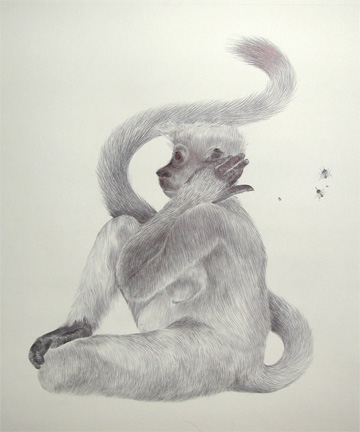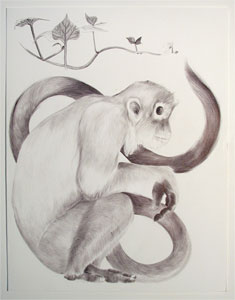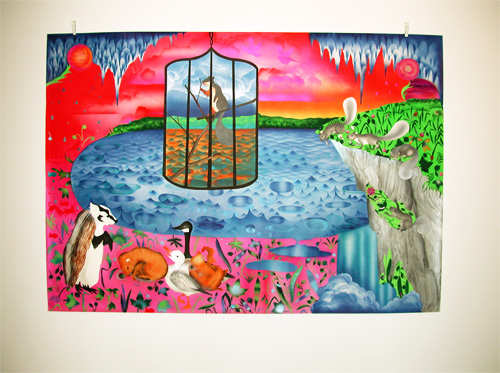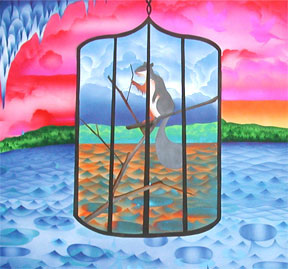Roberta Fallon, half of the indefatigable art-writing twosome who write Philadelphia's artblog, has written nice things about the vox show in the Philadelphia Weekly.
It may seem goofy to flatter a critic who has just written nice things about you, but these ladies really are awesome. They are EVERYWHERE, looking at art and writing about it generously and interestingly every day, regardless of snow or sleet or hideous heat- and they still find time to make art on their own. Their blog is a huge gift to the Philadelphia art scene, and I hope some fat-pocketed publisher decides to hire both of them and give them lots of money. Plus they wrote nice things about my art. What's not to like?
Tuesday, December 20, 2005
Saturday, December 17, 2005
Yesterday's monkey
I finished yesterday's drawing. I usually have to wait a few days after I finish a piece to be able to see it clearly, so I reserve the right to take that back, but I think chances are good that I'm leaving it alone.


Friday, December 16, 2005
What's with the title?
Making art is usually a pretty solitary business, but right now I'm enjoying one of those nice cycles of public response to my work that comes to me every once and a while. I have two shows up: one at Vox Populi Gallery in Philadelphia and one at Moti Hasson Gallery in New York. For the past couple days I've been sending off artist's statements and images of my work to two critics who are writing about the show at Vox Populi. I've been hearing a lot about what people think of my work, which is an odd contrast to the way that I usually experience life as an artist.
This fall being an artist has been about sitting in my comfortable chair by the window drawing monkey fur. I started work on a series of drawings about monkeys recently and the way I'm drawing them is so labor intensive that by the time Thom gets home and asks what I've been doing I find that I can honestly say, "Oh, drawing monkey tail all day." I love the way these drawings are coming out, though. There are two of them in the show at Moti Hasson gallery and I've just posted one on my website.

My favorite monkey subjects are these truly beautiful monkeys called Langours. There's a lady langour at the Philadelphia zoo who is so gorgeous she makes people shut up when they see her. (This is unusual. People are loud at the zoo.) The sign on her cage says that she is the dominant female of her troop of monkeys and explains that Langours are not lazy, that they digest their food by lying together in a heap. Which is what they are usually doing. Langours have a compellingly human quality that makes them fascinating to watch. They are gentle with each other, and they react to being stared at in a way that seems personal. Langours seem to be keeping their dignity intact.
I'm going to try to finish up another monkey drawing today, and then tomorrow I'm going to start a huge piece I'm making for the Philadelphia Airport's exhibition program. It's going to be 48 feet long. I'm making it in 12' sections that will be joined together to make one long narrative in Terminal F. The piece will be hung in a long corridor, and I'm going to try to incorporate a narrative structure that flows over the length of the piece so that people get a sense of plot as they walk along the concourse beside the painting. The trick is going to be trying to make it work from each end.
(Groups of monkeys are called troops, it turns out, or cartloads. Which is confusing. Could I say that there is a cartload of langours in a tree? At least I'm not talking about apes, though. A group of apes is called a shrewdness. Look at this list if you really want to explore the oddness of the way English language speakers experience the natural world.
This fall being an artist has been about sitting in my comfortable chair by the window drawing monkey fur. I started work on a series of drawings about monkeys recently and the way I'm drawing them is so labor intensive that by the time Thom gets home and asks what I've been doing I find that I can honestly say, "Oh, drawing monkey tail all day." I love the way these drawings are coming out, though. There are two of them in the show at Moti Hasson gallery and I've just posted one on my website.

My favorite monkey subjects are these truly beautiful monkeys called Langours. There's a lady langour at the Philadelphia zoo who is so gorgeous she makes people shut up when they see her. (This is unusual. People are loud at the zoo.) The sign on her cage says that she is the dominant female of her troop of monkeys and explains that Langours are not lazy, that they digest their food by lying together in a heap. Which is what they are usually doing. Langours have a compellingly human quality that makes them fascinating to watch. They are gentle with each other, and they react to being stared at in a way that seems personal. Langours seem to be keeping their dignity intact.
I'm going to try to finish up another monkey drawing today, and then tomorrow I'm going to start a huge piece I'm making for the Philadelphia Airport's exhibition program. It's going to be 48 feet long. I'm making it in 12' sections that will be joined together to make one long narrative in Terminal F. The piece will be hung in a long corridor, and I'm going to try to incorporate a narrative structure that flows over the length of the piece so that people get a sense of plot as they walk along the concourse beside the painting. The trick is going to be trying to make it work from each end.
(Groups of monkeys are called troops, it turns out, or cartloads. Which is confusing. Could I say that there is a cartload of langours in a tree? At least I'm not talking about apes, though. A group of apes is called a shrewdness. Look at this list if you really want to explore the oddness of the way English language speakers experience the natural world.
Wednesday, December 14, 2005
The Problem of Prevost's Squirrel
I recently wrote an expanded artist's statement that addresses the work that's showing at Vox Populi Gallery. The show is called The Problem of Prevost's Squirrel, which is also the title of this piece.

(You can see a bigger version on my website here.)
The work in this show revolves around ideas of romanticism and decorative beauty. The title refers to an actual breed of squirrel that lives in a cage at the Philadelphia Zoo that is very similar to the one pictured in the piece. Prevost’s Squirrels are tricolored, comparatively decorative squirrels. I was struck by the situation of the Prevost’s Squirrel at the zoo because the Philadelphia Zoo has a huge population of common grey squirrels who run freely around the grounds. My reason for using this situation as a metaphor had to do with some ideas I’ve been dealing with in art for a long time now. I’m interested in the ways that we classify beauty: I want to know why some kinds of beautiful things are pretty, some are decorative, and some are ornamental.
I’m suspicious of the impulse to classify kinds of beauty, and I suspect that the ways that we associate certain kinds of aesthetics with silliness has a lot to do with our awareness of the amoral power of aesthetics. It strikes me as rather Victorian that it’s common to insult a painting by calling it decorative: the insult implies that the beauty in the piece is not aspiring to some higher good, as if it has to justify its prettiness by being somehow pure.
I have a real love/hate relationship with the traditions of romanticism, and my visual language comes out of that ambivalence. River is my take on the Preraphaelites: there’s a badger Ophelia on the left, and a pile of narcissistic red-headed bears on the right, one of whom is lifting her skirt. Conflict is a painting about the more common, sinister interpretation of decoration as a symbol of social or capitalist excess. I use lots of decorative, ornamental, girly and popular culture visual strategies in order to make work that’s very accessible and viscerally appealing. I try to attract the viewer to the work in order to play out narratives about power and romanticism.
I use animals because I think they highlight the unnaturalness of the way that we have associated decorative imagery with femininity. The big dresses I use in lots of my work have a particularly feminine history, but I don’t want them to be able to subsume the character of the person inside them: making animals wear big dresses is a way of not allowing the stories I tell to be about individuals. We generalize animals, and I’d like to be able to generalize about the associations between decoration, femininity and fertility. It’s also a way to offset all the assumptions people have about images like flowers and pink bows with a sense of fierceness. I haven’t come to any conclusions about the ways these issues interact, but I know that working with animals in a natural setting makes sense when I’m talking about the history of decoration and femininity; the girliest thing a woman can do is wear a flowered dress, and the most fertile symbol in nature is arguably a flower.

(You can see a bigger version on my website here.)
The work in this show revolves around ideas of romanticism and decorative beauty. The title refers to an actual breed of squirrel that lives in a cage at the Philadelphia Zoo that is very similar to the one pictured in the piece. Prevost’s Squirrels are tricolored, comparatively decorative squirrels. I was struck by the situation of the Prevost’s Squirrel at the zoo because the Philadelphia Zoo has a huge population of common grey squirrels who run freely around the grounds. My reason for using this situation as a metaphor had to do with some ideas I’ve been dealing with in art for a long time now. I’m interested in the ways that we classify beauty: I want to know why some kinds of beautiful things are pretty, some are decorative, and some are ornamental.
I’m suspicious of the impulse to classify kinds of beauty, and I suspect that the ways that we associate certain kinds of aesthetics with silliness has a lot to do with our awareness of the amoral power of aesthetics. It strikes me as rather Victorian that it’s common to insult a painting by calling it decorative: the insult implies that the beauty in the piece is not aspiring to some higher good, as if it has to justify its prettiness by being somehow pure.
I have a real love/hate relationship with the traditions of romanticism, and my visual language comes out of that ambivalence. River is my take on the Preraphaelites: there’s a badger Ophelia on the left, and a pile of narcissistic red-headed bears on the right, one of whom is lifting her skirt. Conflict is a painting about the more common, sinister interpretation of decoration as a symbol of social or capitalist excess. I use lots of decorative, ornamental, girly and popular culture visual strategies in order to make work that’s very accessible and viscerally appealing. I try to attract the viewer to the work in order to play out narratives about power and romanticism.
I use animals because I think they highlight the unnaturalness of the way that we have associated decorative imagery with femininity. The big dresses I use in lots of my work have a particularly feminine history, but I don’t want them to be able to subsume the character of the person inside them: making animals wear big dresses is a way of not allowing the stories I tell to be about individuals. We generalize animals, and I’d like to be able to generalize about the associations between decoration, femininity and fertility. It’s also a way to offset all the assumptions people have about images like flowers and pink bows with a sense of fierceness. I haven’t come to any conclusions about the ways these issues interact, but I know that working with animals in a natural setting makes sense when I’m talking about the history of decoration and femininity; the girliest thing a woman can do is wear a flowered dress, and the most fertile symbol in nature is arguably a flower.
Subscribe to:
Posts (Atom)
